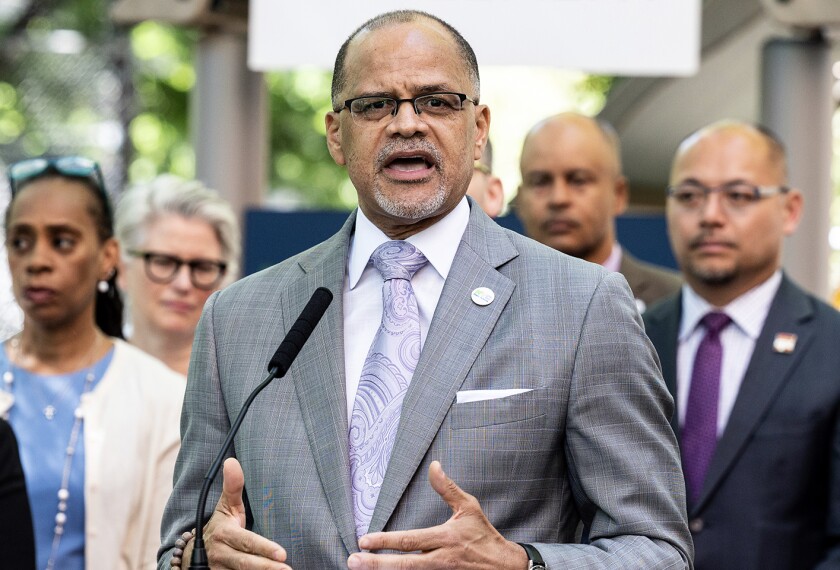This upcoming school year promises to be unlike any other. Now is the time to get prepared.
Many local officials across the country are balancing the advice of public-health experts against the administration’s reckless demands to open all schools everywhere with in-person instruction, regardless of the threat to the health of students, families, teachers, and staff. Some of the largest school districts across the nation already have announced that their schools will rely on remote instruction or a mix of in-person and distance learning. The simple truth is that remote and hybrid learning will be with us for the foreseeable future, as we continue to grapple with the coronavirus pandemic.
In that context, denying students access to broadband is tantamount to denying them access to education.
We—as a former U.S. secretary of education and a current member of the Federal Communications Commission—believe this year’s summer assignment is clear and urgent: We must make sure that every student has the home connectivity and devices they need to make the most of learning during the coming school year.
Even before this pandemic, new technology was helping skilled educators redefine the student-learning experience. Technology can enhance and enrich instruction; teachers can use adaptive- learning platforms to address students’ unique learning needs or they can pair traditional study with a virtual tour of the ocean floor or the ancient pyramids. The transition to these tools can also better prepare students for the digital world, from using PowerPoint to prepare a 4th grade research report to using computer-assisted design software in a high school pre-engineering class. But it also raises profound equity challenges.
For so many students, the classroom is no longer just inside the school building."
The U.S. Senate Joint Economic Committee reported in 2018 that there were more than 12 million students who fell into the “homework gap”—meaning they lack the necessary internet access at home to complete their homework assignments—and data from Common Sense Media this year indicates the number might be as high as 16 million. More than 70 percent of educators assign homework that requires the internet. As a result, before the pandemic, these students without Wi-Fi access at home resorted to seeking out venues that offered it for free. They were the students nursing a drink at a fast-food restaurant, or sitting on the library steps with a laptop while they typed out their papers, or lingering in the school parking lot to complete their homework long after the final bell rang.
But now the homework gap has turned into a devastating learning chasm with so many students disconnected during this pandemic at the same time as schooling moved online this spring.
In fact, Common Sense Media’s new statistics suggest that gaps in home-internet access are especially dire in rural areas, where 37 percent of students lack internet connections at home. Additionally, we see racial disparities within the lack of access: At least a quarter of all Latinx, Black, and Native American students lack adequate home connectivity.
With some form of online instruction certain to continue in the fall, we need to address this connectivity crisis now. A recent McKinsey report estimated that, this past spring, the combination of inadequate internet access, insufficient professional development and support for teachers, and uneven instruction cost students an average of seven months of learning (with a disparate impact of nine months for Latinx students and 10 months for Black students).
We need a national policy to leave no child offline.
Here’s how to do it: E-rate.
The E-rate is the nation’s largest education technology program, and it is run by the FCC. Right now, it provides support for internet and Wi-Fi access in classrooms in every state across the country. But, with the ongoing pandemic, it’s time to modernize the program. After all, for so many students, the classroom is no longer just inside the school building. It is now online.
We can meet the current moment by adjusting E-rate so that it supports connecting kids to virtual school.
With in-person instruction still up in the air, the FCC should use the remainder of the summer to update the E-rate program so every student is connected at home this fall. Congress is pressing for this to happen with the proposed Emergency Educational Connections Act that would direct the FCC to update the E-rate program to meet this moment. But there’s no reason the FCC can’t get started right now.
Of course, making sure that students are connected is only part of the equation. There are other actions we can take to ensure online learning is as effective as possible.
Congress can step up with adequate funding to stabilize state and local budgets to prevent budget cuts that would devastate schools and force layoffs. Congress also can provide targeted funding to address student-learning loss from last spring as well as students’ socioemotional needs as kids and their families navigate the pandemic.
In addition, Congress and state governments can encourage districts to implement multilingual digital-learning platforms to be fully inclusive. Districts should develop thoughtful plans for the kinds of teacher professional development and collaboration that will be essential to make remote or hybrid learning successful. Federal, state, and district resources must then be dedicated to ensuring educators can effectively teach, build relationships with, and assess their students’ learning remotely. Establishing a highly functioning, comprehensive online learning system will require an all-hands-on-deck approach.
Navigating the politics of the moment and the logistics of even a partial reopening of in-person instruction are complicated. But that’s no excuse for squandering the opportunity to make online instruction more effective this fall than it was in the spring. We need to start now, so that every student has a fair shot at getting the connection and content they need to continue learning during this crisis.





